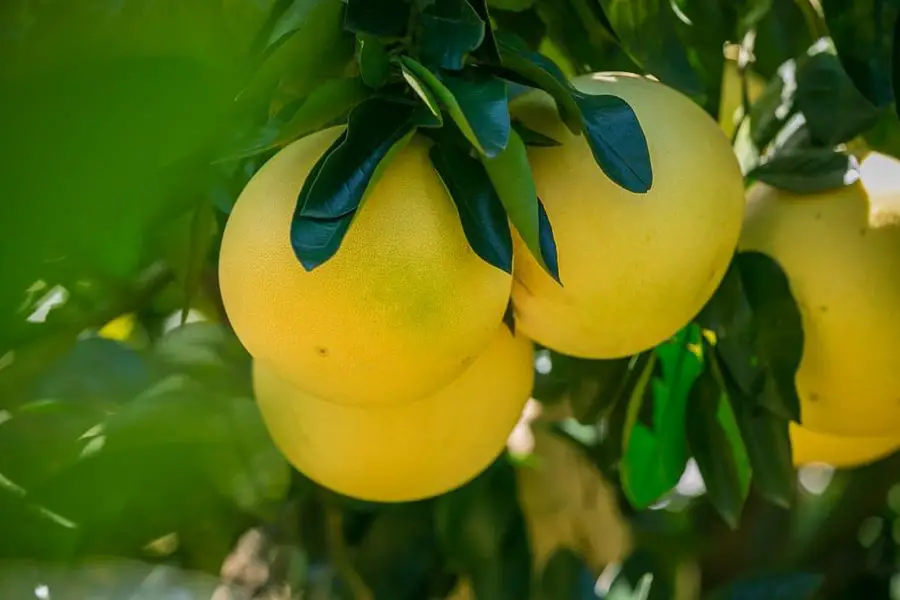This post contains affiliate links. If you buy something from one of our links we may earn a commission. Thanks

If you want to grow citrus trees but are too far north to grow them outdoors I have good news. You can learn how to grow pomelo in a pot indoors.
Growing pomelo indoors is a feasible way to enjoy this large, sweet citrus fruit even if you live in a colder climate. Opt for a dwarf-grafted tree for quicker fruiting and easier maintenance. Ensure at least 6 hours of direct sunlight daily or supplement with an LED grow light. Use well-draining soil in a pot with drainage holes and keep the soil consistently moist.
We will tell you how to grow pomelo in a pot in this article.
What Is A Pomelo?
 The Pomelo Citrus Maxima is well-named because it is the largest citrus fruit and produces fruit that is 6-10 inches in diameter.
The Pomelo Citrus Maxima is well-named because it is the largest citrus fruit and produces fruit that is 6-10 inches in diameter.
It is the ancestor of grapefruit trees but it is much sweeter.
In Chinese culture, pomelos are considered a symbol of prosperity and good luck and are often given as gifts for the Chinese new year.
What Does A Pomelo Taste Like?
Pomelo, also known as Chinese grapefruit, is a large citrus fruit that is known for its sweet and slightly tangy flavor.
The tasty fruits are juicy and have a distinct taste. It’s less bitter than grapefruit but has a stronger and more complex flavor profile.
The rind of the fruit is thicker than that of a grapefruit, and it’s more fragrant and less bitter.
Honey is the most common variety sold in stores but there are at least a dozen others. It has been grown in China for over 500 years and can weigh 1-4 pounds.
The taste of pomelo can vary depending on the variety and the stage of ripeness. When fully ripe, pomelos can be sweeter and less acidic than grapefruits.
They also have a distinct floral aroma that is quite pleasant. Some varieties of pomelo can be more tart or sweet, and some can have a more complex flavor profile with hints of honey or vanilla.
In general, pomelo is a delicious and refreshing fruit that can be enjoyed on its own or used in a variety of dishes, from salads and cocktails to desserts and jams.
It’s a great source of vitamin C and other nutrients, and it’s a tasty way to add some variety to your citrus fruit intake.
How To Grow Pomelo In A Pot
It is easy to grow indoors but needs 6 hours of direct sunlight daily to produce its fruit. If you don’t have 6 hours of light the tree will still grow but may not fruit.
So the most important thing for growing citrus indoors is meeting their lighting requirements. They need 6 hours of full sun to produce fruit.
If you don’t have enough sunlight you can use an LED grow light to provide supplemental light.
Once the lighting requirement is met the rest of growing container citrus trees is pretty easy.
Pomelo can be grown from seed, cuttings, or a grafted tree. To grow them indoors you want to start with a dwarf tree. 
Grafted Dwarf Pomelo Vs Seeds
Since we want to grow it indoors we want to start with a dwarf pomelo because a full-sized regular tree can grow to 16-50 feet outdoors.
A grafted tree on dwarf rootstock can be kept at 6 to 8 feet. It is best to grow dwarf citrus trees for containers because they bear them sooner and are easier to maintain.
I don’t recommend growing pomelo from seed. It will take at least 5 years before it produces fruit.
It also may never produce fruit or produce fruit that is different from what you expect. Seeds do not grow true to type.
Fruit trees are never grown from seed because of this. They are grown from a cutting from a desirable tree and the cutting is either rooted or grafted onto a citrus rootstock.
If a cutting is used the tree will be way too large for indoors unless it is dwarfed.
So while grafted pomelo trees are much more expensive than seeds or seedlings they will produce the desired fruit in 2 to 3 years.
If you only want a foliage plant you can use seeds or seedlings but if the goal is to produce quality fruit you need a grafted tree.

Pomelo Pot Size And Soil
You will want to start with an 8 to 12-inch pot but you will want to repot into a size larger pot every year or two. Make sure the pot has drainage holes.
Some people like to use terra cotta pots for citrus trees but plastic pots are just fine. They are lighter in weight and they don’t break.
You may want to move your tree outdoors during the summer and back inside again in the fall so having a lighter unbreakable pot is definitely an advantage.
Pomelo trees prefer moist well-drained soil so you can use citrus soil or mix your own.
You can use a mix of 50% perlite and 50% coco coir. You can also use potting soil but I would add some perlite to lighten the mix and improve drainage.
Planting and Care – How To Plant Pomelo In A Pot
When planting pomelo in a pot, it’s important to choose a container with drainage holes and fill it with a well-draining soil mix.
Bare-root fruit trees should be placed in a pot large enough to spread the roots out.
Trim off any broken or damaged roots and center the plant in the container as you fill in around the roots with soil.
The pomelo tree should be planted at the same level it was in the previous container.
If you are growing a grafted tree it is important not to bury the graft.
After planting, water the tree well to remove any air pockets and keep the soil consistently moist but not waterlogged.
Temperature
Pomelo grows in warmer climates and prefers temperatures between 75 and 85. It can be grown outdoors in zone 10 and in zone 9 with protection.
Temperatures in the mid to upper 20s can kill or damage it so for most of us it will be an indoor plant for at least part of the year.
Fertilizing
 Fertilizing your pomelo is easy.
Fertilizing your pomelo is easy.
I recommend using Jobes Organics fertilizer spikes.
They are easy to use and last for 2-3 months.
They are designed for container-grown citrus.
Using 2 spikes for a 12-inch pot or 3 for an 18-inch pot takes the guesswork out of fertilizing.
They provide a 3-5-5 fertilizer blend along with micronutrients and beneficial bacteria.
Watering And Sunlight Requirements
Pomelo trees require regular watering, especially during the hot months, but make sure to not over-water as it can cause root rot.
If you are unsure stick your fingers into the soil. If the top inch or two is dry it’s time to water.
Don’t let the plant sit in standing water inside the tray.
The ideal location for a pomelo tree in a pot is in a sunny spot, where it will receive at least 6 hours of direct sunlight per day.
If you can’t provide this, you can supplement it with a grow light.
During the warmer months, you can move your pomelo outdoors but remember freezing temperatures can damage or kill your tree.
Tips for pruning and training the plant
Pomelo trees need regular pruning to encourage branching, control the size and shape of the tree, and remove any dead or diseased wood.
A healthy pomelo can grow 2 feet per year which is why pruning will be necessary if you are growing them indoors. These trees can also live for a hundred years.
Pomelo fruit is large so you want to build a sturdy framework of branches to support the fruit.
Branches with wider crotches should be selected. Upright branches with a narrow-angle are more likely to tear under the weight of fruit.
Start pruning your pomelo tree when it’s young and continue to do so as it grows.
You can train the tree to a single trunk or spindle by removing all the long side branches, this will make it easier to harvest and care for. 
Pests and Diseases
Pests and diseases can be a major challenge when growing pomelo in a pot. Here are some common pests and diseases that affect pomelo and ways to prevent and treat them:
Pests:
Mealybugs: These small, white, cottony insects can be found on the leaves and stems of the tree. They suck the sap from the plant, causing yellowing and wilting of the leaves. To treat mealybugs, you can use an insecticidal soap or neem oil.
Scale insects: These small, round, hard-shelled insects attach themselves to the branches and leaves of the tree and suck the sap from the plant. They can cause yellowing and wilting of the leaves. To treat scale insects, you can use horticultural oil or insecticidal soap.
Aphids: These small, green or black insects can be found on the leaves and stems of the tree. They suck the sap from the plant and can cause yellowing and wilting of the leaves. To treat aphids, you can use an insecticidal soap or neem oil.
Diseases:
Citrus canker: This is a bacterial disease that causes small, raised, sunken cankers on the branches, leaves, and fruit of the tree.
The cankers can cause leaf drop and fruit drops. To prevent citrus canker, make sure to keep the tree healthy by providing it with the right amount of water and sunlight, and by regularly pruning it.
If you notice any signs of citrus canker, remove the affected parts of the tree and treat it with a copper-based fungicide.
Citrus greening: This is a bacterial disease that causes the yellowing of the leaves and fruit drop. There is no cure but it is spread by an insect and is a problem in commercial citrus areas.
Citrus Greening (Candidatus Liberibacter asiaticus) is one of the most serious citrus plant diseases in the world. It is also known as Huanglongbing (HLB) or yellow dragon disease. Once a tree is infected, there is no cure. While the disease poses no threat to humans or animals, it has devastated millions of acres of citrus crops throughout the United States and abroad. Citrus greening is spread by a disease-infected insect, the Asian citrus psyllid (Diaphorina citri Kuwayama or ACP), and has put the future of America’s citrus at risk. Infected trees produce fruits that are green, misshapen and bitter, unsuitable for sale as fresh fruit or for juice. Most infected trees die within a few years. https://www.aphis.usda.gov/aphis/resources/pests-diseases/hungry-pests/the-threat/citrus-greening/citrus-greening-hp
It’s important to regularly check your pomelo tree for any signs of pests or diseases and take action immediately if you notice any.
It’s also important to practice good cultural care, such as proper watering, fertilizing, and pruning to keep the tree healthy and reduce the likelihood of pests and diseases.
Harvesting
Pomelo fruit is usually ready for harvest in late fall or early winter.
It can take several years for a grafted tree to start bearing and it can take up to 8 years for a seedling to bear fruit.
Fortunately, the pomelo is self-fruitful and does not need a second tree to pollinate it.
You can tell when pomelos are ripe by their color, they are usually yellow-green or yellow and their skin should be slightly soft to the touch.
How to harvest pomelo:
When harvesting pomelo, use a sharp pair of pruning shears or a knife to cut the fruit off the tree.
Hold the fruit with one hand and cut it off with the other, leaving a small stem attached to the fruit.
Be careful not to damage the tree or leave any stubs, as this can lead to disease and rotting.
Growing Pomelo FAQs
Growing pomelo indoors can be a rewarding experience, but you might have questions about the care, sunlight requirements, or even the type of pomelo tree to choose for indoor cultivation.
Below are answers to some commonly asked questions to help you successfully grow pomelo indoors.
Q. What type of pomelo tree is best for indoor growing?
A. A dwarf grafted pomelo tree is the best choice for indoor growing as it bears fruit quicker and is easier to manage in terms of size.
Q. How much sunlight does an indoor pomelo tree need?
A. An indoor pomelo tree requires at least 6 hours of direct sunlight daily. If natural sunlight is insufficient, you can use an LED grow light as a supplement.
Q. What kind of soil is best for growing pomelo in a pot?
A. Well-draining soil is crucial for pomelo trees. You can use a mix of 50% perlite and 50% coco coir, or use citrus-specific soil.
Q. How often should I water my indoor pomelo tree?
A. Keep the soil consistently moist but not waterlogged. Check the top inch or two of soil; if it’s dry, it’s time to water. Make sure the pot has drainage holes to prevent root rot.
Final Thoughts
In conclusion, growing pomelo in a pot is a great way to enjoy the delicious fruit while also having a unique and beautiful addition to your indoor or outdoor garden.
By following the tips outlined in this post, you can successfully plant, care for, and harvest your own pomelo.
Remember to choose the right pot size and material, use appropriate soil and fertilizer, and keep an eye out for pests and diseases.
Growing pomelo in a pot can be a rewarding experience, and you can also enjoy growing different citrus plants. Learn more about growing citrus indoors.
If you are looking for a smaller citrus plant to grow indoors consider a calamondin orange. We have an article on calamondin orange care for you.
You can get more information from Wikipedia on pomelos here
Related Content
Visit my Amazon Influencer Page for videos and gardening products Grow Your Own Garden






